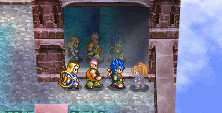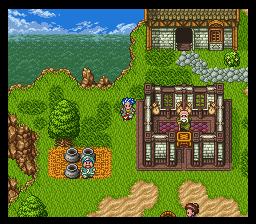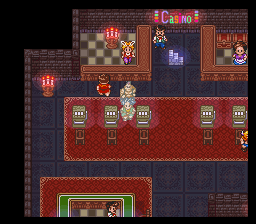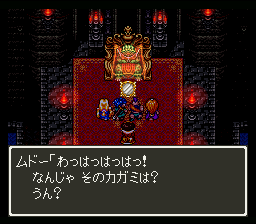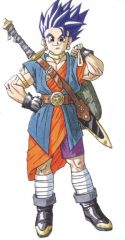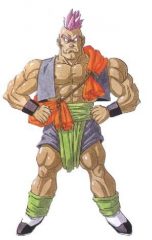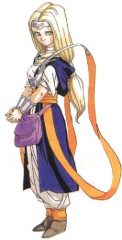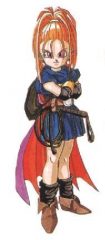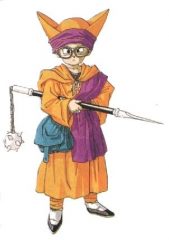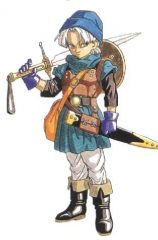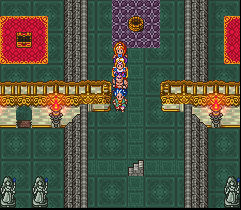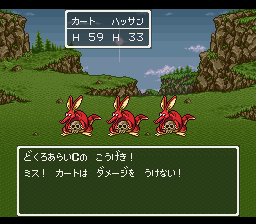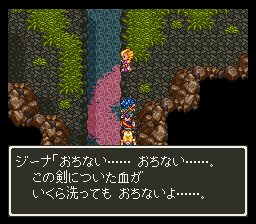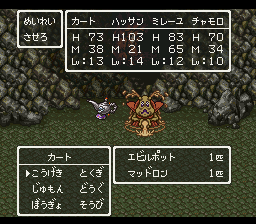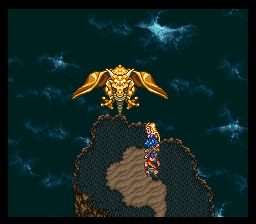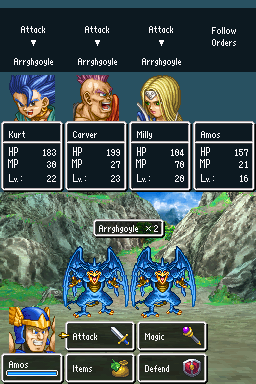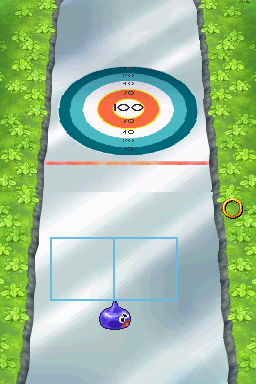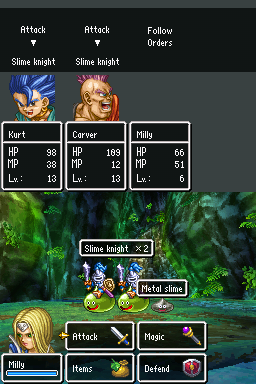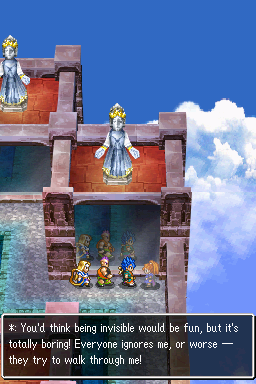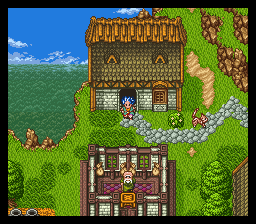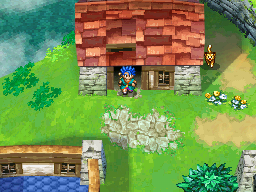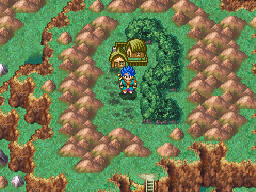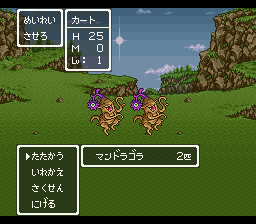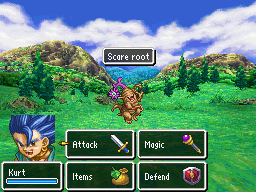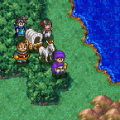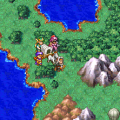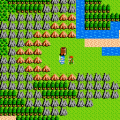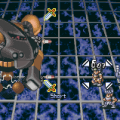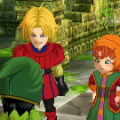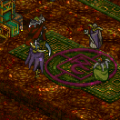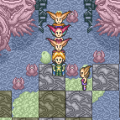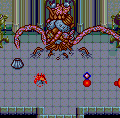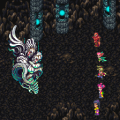- Dragon Quest (Introduction)
- Dragon Quest
- Dragon Quest II
- Dragon Quest III
- Dragon Quest IV: The Chapters of the Chosen
- Dragon Quest V: Hand of the Heavenly Bride
- Dragon Quest VI: Realms of Revelation
- Dragon Quest VII: Fragments of the Forgotten Past
- Dragon Warrior VIII: Journey of the Cursed King
- Dragon Quest XI: Echoes of an Elusive Age
- Slime Mori Mori Dragon Quest
- Dragon Quest Heroes: Rocket Slime
- Slime Mori Mori Dragon Quest 3
- Dragon Quest Heroes
- Dragon Quest Heroes II
Box Shots Go Here
Dragon Quest VI marks a huge change for the series – it’s the first game to have been developed by Heartbeat, as opposed to Chunsoft, who went off to evolve its Mysterious Dungeon spinoff series. It changes up the visual style and makes several other improvements that have been carried forward into subsequent games (and remakes of prior games).
Dragon Quest VI features a “dual world” setup similar to The Legend of Zelda: A Link to the Past. But instead of featuring a “Light World” and “Dark World”, Dragon Quest VI is broken up into the “Real World” and “Dream World” (which is the “Maboroshii no Daichi” or “Illusionary Land” mentioned in the title.) The story begins with a trio of young warriors mounting on assault on the evil warlord Murdaw. However, you and your party prove no match for his power, and all of them are banished into thin air. Then, you awaken back in your room, your confrontation apparently having been just a dream. Upon resuming your daily routine, you finds a strange gaping hole in the earth. You jump in, only to discover another world almost exactly like your own. However, you appear only as a spectre, and most people can’t see or interact with you (this leads to some amusing tricks you can play on villagers – you can actually try to convince a hapless clergyman that you’re God.). Eventually you come across the companions from your dream (who’ve lost their memories, of course), before eventually figuring out a way to jump between both worlds.
Then you learn the truth about the “dream world” – it’s a little confusing, but the opening segment wasn’t really a dream, but rather it took place in the real world, as Murdaw had banished you to the dream world. The rest of the inhabitants of the real world have projected their minds into this dream world, leading to some interesting connections – for example, one guard in the real world hates his name, and his identical version in the dream world has the name he wishes he had. Naturally, you’ll do a lot of jumping back and forth between the two worlds, uncovering the hopes and dreams of the townspeople you run across, and fixing their problems.
You’ll still have to deal with Murdaw of course, although he’s hardly the final boss of the game. The true baddie is an even monstrous foe named Deathtamoor, who inhabits a dimension of darkness between the two worlds. It’s a pretty cool plot, with plenty of cool twists, and seems to have directly influenced later RPGs – needless to say, Chrono Cross and Final Fantasy X don’t seem so innovative when you compare them to Dragon Quest VI. This installment also finishes up the “Castle in the Sky” trilogy, although here it’s simply referred to as “Zenith Castle”. The events in the game reveal that, chronologically, the game takes place before the other two games, as the Dragon Quest VI protagonist is the Zenithian Hero references in Dragon Quest IV.
Hero
At the beginning, the Hero is a simple inhabitant of a remote village, venturing only to sell his goods – at least, until he discovers the alternate world. Here, people recognize him as being the prince of Somnia.
Carver (Hassan)
Carver is one of the buddies from your dreams. As his appearance would suggest, he’s more about might and muscle than flexibility. He’s a simple carpenter in the real world but dreams of being a powerful martial artist, which informed his dream persona.
Milly (Muriel)
Your other friend from your dream, Milly (known as Milayou in the Dragon Quest Monsters localization) is your token magic user. She’s the only person that can see the Hero and Carver when they first enter the alternate dimension.
Barbara
Barbara also appears as a spectre at first, but you help her materialize, and she ends up joining your quest. She’s a runaway who’s lost her memory, and also has magic powers. Also looks a lot like Marle from Chrono Trigger, but that should be expected from Toriyama’s artwork.
Nevan (Chamoro)
Nevan is a healer from the holy city of Ghent who joins your party when you get your ship, and comes from a prestigious family.
There are also two other minor, optional characters – Amos, a local warrior who has the ability to turn into a beast, and Lizzie, a dragon who will join the team after being defeated.
The graphics have improved significantly over its predecessor, featuring much larger characters, and more detailed terrain, putting it on the level with other SFC RPGs like Final Fantasy VI. The battle backgrounds now take up the whole screen instead of being displayed in a window, and all of the enemies have attack animations, which helps make the action feel less static. The music is also substantially better, featuring much stronger instrument samples, which is especially noticeable with the percussion. It was actually arranged for the SFC by Hitoshi Sakimoto, known for his music work on games like Tactics Ogre. The battle theme is particularly dramatic, with the opening bars recalling some of the Final Fantasy battle themes. The movement is much smoother, the characters walk faster, and the whole game feels like Dragon Quest finally crawled out of its archaic shell, while still keeping what makes the series unique. It uses a 32 Mb ROM size, nearly three times the size of DQV‘s 12 Mb.
Dragon Quest VI brings back the class system from Dragon Quest III, with a number of improvements. Once you’ve defeated Murdaw, you can visit Alltrades Abbey (also called Dharma Shrine) in order to take on a job. These will make some changes to base your stats, and allow you to learn skills of that job. Similar to Final Fantasy III or V, you can switch classes any time you want instead of waiting until you hit Level 20 (although you need to head to the abbey to do this). Your class level is now separate from your main experience level, and there are eight class levels within a given job. You gain class experience by fighting a set number of battles, but they need to be about your level or stronger, so you won’t gain anything if you grind against enemies that are too weak. When you level up your class rank, you’ll get a new skill, which you’ll keep even if you change to a different job. The only exception are some of the non-battle talents, like the Thief’s ability to steal an item after combat, or the merchant’s ability to gather a few extra gold. The classes at the beginning of the game should be familiar – the standard Warrior, Martial Artist (Soldier), Priest (Healer), Mage (Wizard), Merchant, and Gadabout (Goof-Off) – as well as Thief, Dancer and Monster Master. The Monster Mauler class lets you tame certain monsters a la Dragon Quest V (at least in the SFC version), but there’s not as many beasts to find (only 18), since it’s not really the focus of the game. Since most of the unique monster skills are already learnable in the other classes, they’re almost redundant. Once you master multiple specific base classes, you can open up the advanced classes, which include Gladiator (Warrior & Martial Artist), Armamentalist (Warrior & Mage), Paladin (Martial Artist & Priest), Ranger (Thief, Merchant & Monster Master), Sage (Priest & Mage) and Luminary (Dancer & Gadabout). If you really put a lot of effort into it, you can even enable the Hero class, although it’s much easier for the main character to get to this rank. It’s a cool way to customize your characters, but unless you plan out your characters growths ahead of a time, you could potentially end up with an underpowered party. It also requires a lot more grinding to get the skills you want.
It’s also a huge game, much larger than any of the games before it. After all, there are two large overworlds, plus the ability to explore underwater (once you obtain the harp), plus the demon world near the end of the game. It’s also much more open-ended – once you’ve defeated Murdaw, the game opens up and you can do anything in almost any order. There are several methods of transportation beyond the normal ship, including a magic carpet, a flying bed, a floating island, and Pegasus, which will let you take your caravan to the sky. The downside to all of this is that it does feel like the game drags on, plus it gets a little bit confusing. There’s no real visual distinction between the two worlds, with the only change being a slight variation in the overworld music.
Other improvements include the addition of the Bag, which allows you to store additional items without your characters having to hold them, though it can’t be accessed during battle. You also have an “Style” stat, which changes based on your equipment. Increase your Style will help you win a style contest later in the game, which allows for more prizes. There’s also the Slime Battle Arena, where you can pit various members of the Slime family against each other for prizes. The Medal system has also changed, in that you’re given specific prizes for obtaining a certain number of Medals, rather than using them as currency to purchase the items you want. In the SFC version, you can also bring up a world map (once you obtain it) by hitting the “R” button, though it’s displayed all of the time on the top screen in the DS version. The day/night cycle is also gone, and only changes as the plot dictates. This is also the first Dragon Quest game that lets you enter wells, which here, often acts as passage between the two worlds.
Like its immediate predecessor, Dragon Quest VI was passed over for localization, since Enix had closed up shop in America, and Square – one of the only companies willing to translate any RPGs into English – was too busy trying to figure out how to get their own games to sell.
Unlike the previous games, Dragon Quest VI didn’t see any remakes until 2008, with the DS re-release, which was the first time it was released in English. It includes the same visual and the same balancing tweaks and quality of life enhancements as the other DS games, as well as some altered maps. In the SFC version, each of the characters had unique resistances, but these were all removed here. A new additions includes a slime curling minigame called “Slippin’ Slime” using the touch screen. The monster tamer class (called Monster Master here) has been changed completely so it no longer recruits monsters from battle, but instead there are various subquests you can accomplish to draft various members of the Slime family into your team. This received quite a bit of criticism when it was released in Japan, especially when an interview with Yuji Horii basically said “If you want to recruit monsters, please play Dragon Quest Monsters.” This made it seem like a game was being cut back in order to sell one of their spinoffs. Regardless of these games, Lizzie still joins you, at least. Amos gets his own sprite (he was just a generic warrior sprite before) and the Zoom spell can now take you to Alltrades Abbey, making changing jobs easier than even. A fortune teller also gives you hints on where to go next, making some of the traveling a little less aimless than the SFC version.
The SFC version also has a “conversation remembrance” function that let the player stores various conversations and then recall them for later use, essentially acting as an in-game note taking function. The DS version has a party chat feature, where the other members will (usually) remind the player of what they’re supposed to be doing, making the conversation remembrance system redundant, so it was removed.
The translation is of the same high quality as the rest of the English DS Dragon Quest games, though it was translated by famed localization studio 8-4 rather than Square’s internal team. Nearly all of the names of the cast members have been changed though. This is probably because many of them appeared in Dragon Quest IX as guest characters, and since that translation changed their names, they were also amended here to keep consistent. The subtitle is Realms of Revelation in North America but Realms of Reverie in Europe. The name for puff puff was also changed to “pattycake” (probably a reference to Who Framed Roger Rabbit?”), at least when referring to the act done by women. The skill retains the same name.
However, there’s still something disappointing about this remake. The DQIV and DQV remakes were unquestionably an improvement over their original Famicom and Super Famicom counterparts, since they were graphically pretty simple. But the original DQVI was a fantastic looking game, and even though the animated sprites are much better in the DS version, it’s hard to shake the feeling that the low res 3D backgrounds are actually a step backwards. The music quality lacks the crispness of the SFC version too, and sounds slightly worse. In unifying the visual style of all of the surrounding games – using the same battle backgrounds, tiles, and NPC sprites – it removes many of the aspects that made the original release so special.
In general, Dragon Quest VI is considered the weakest of the Zenithian trilogy. Not because it’s actually bad – it’s a little bloated but otherwise solidly put together – but just because it doesn’t quite have the narrative draws of the prior two games. The dual-world setup is intriguing for the opening hours, but doesn’t quite have the enduring appeal of the multi-generational DQV or diverse cast of DQIV. It’s still an excellent game though, and set up a template that was expanded on in the next installment.
Screenshot Comparisons
